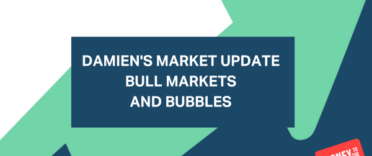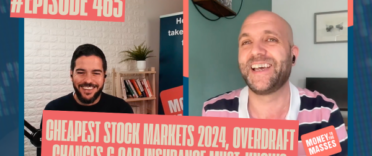The 145th episode of my weekly YouTube show where I discuss what is happening in investment markets and what to look out for. This week I talk about how equity markets have stalled as well as the reasons why and what is likely to happen next.
Each show lasts between 5-10 minutes and is aimed at DIY investors (including novices) seeking contemporary analysis to help them understand how investment markets work.
Subscribe to my YouTube channel to receive my weekly analysis of investment markets or alternatively, you can listen via my weekly Midweek Markets podcast below.
Midweek Markets weekly podcast
Other ways to watch, listen and subscribe
You can listen to other episodes and subscribe to the show by searching 'Money to the Masses' on Spotify or by using the following links:
Abridged transcript - Midweek Markets episode 145
Last week I talked about keeping an eye on the DAX. Firstly as a broad measure of European equity sentiment, the DAX has mostly traded sideways since my last show, in a relatively tight range and is down less than 1%. It is either a sign that the recent rebound in German and European equities is pausing for breath, before the next leg higher, or running out of steam altogether.
It’s a similar story with the S&P 500, albeit a slightly more positive one as the index is up just over 1% since my show last week. But once again the rebound has stalled. From a purely technical analysis perspective, this pause was to be expected. With equity markets having rebounded so far and so fast from the post-invasion lows (the S&P 500 is up over 7% while the DAX is up 11%) we are seeing them hit resistance. If you recall resistance from a technical analysis point of view is a level/price that an asset or index has trouble breaking above. These are relatively easy to spot if you look at a chart of an index. For the S&P 500 that level has been 4500, while the DAX has struggled with 14,500. Both levels have been tested but so far have proved too difficult to crack. If either threshold is breached to the upside then the rebound will likely have further to run. Furthermore both these levels lie just above their respective index’s 200 day moving average. A close back above these levels would be seen as bullish, while remaining trapped below is generally considered a bearish sign,
But while equity markets may have stalled for a time, until a catalyst presents itself for a move higher or lower, many analysts are left scratching their heads as to why equity markets are proving so resilient. The economic backdrop hasn’t changed, with rising inflation and signs of slowing economic growth. The war in Ukraine is still raging, although UK media reports that the Russian advance has stalled. Meanwhile, key central banks have begun raising interest rates and tightening monetary policy (i.e the US Federal Reserve and the Bank of England), or at least implying they will (in the case of the ECB). But rather than equity markets falter, as they have previously at even the mention on monetary policy tightening, they have continued to show signs of strength, even in the face of rising commodity prices. The price of a barrel of oil is back $100 a barrel of Brent crude.
Whether it's complacency or justified confidence the bond market has anything but stalled this week. In fact, following last week’s US Federal Reserve meeting and a series of hawkish soundbites from Jerome Powell, essentially saying that the Fed would tighten policy as fast as it needed to, the 10 year US treasury yield accelerated higher, hitting 2.41, up from 2.2% the week before. This was the highest level in 3 years and don’t forget when bond yields rise it means that the value of the bonds fall. But it's not just a US phenomenon, the FT reported that The Bloomberg global aggregate index, a broad gauge of government and corporate debt around the world, has fallen over 11% since its peak in January 2021. These are historic moves and greater than anything we saw during the financial crisis, but they are also the biggest moves seen since the index was launched in 1990.
It means that the bond portion of any portfolio has been hammered in 2022. Not only that but on a number of occasions this week we’ve seen bonds and equities move in sync - i.e. when equities have tumbled so have bonds and vice versa. That’s not normal. The bond market is clearly still wrestling with the idea that central banks are about to begin tightening monetary policy aggressively. Yields on longer-dated bonds are falling, and in some instances are lower than those on shorter-dated bonds. This has been seen in some parts of the US treasury market and is known as yield curve inversion. And the only reason why you would loan the US government money for a longer period of time at a lower effective interest rate is that you think yields will fall in the future. Or in other words, the Fed will raise interest rates too soon, causing the post-pandemic economic recovery to stall and be forced to cut interest rates once again in order to support the economy. Or in other words, the Fed is about to make a huge policy mistake. The moves in bond markets this week suggest that this school of thought is becoming more entrenched. With so much uncertainty it's as if bond and equity investors are driving into fog. Bond investors have whacked their hazard lights on to warn other drivers of the dangers and to avoid a potential crash. Equity investors meanwhile are accelerating into it (ignoring the fundamentals), certain that sunshine and blue skies lie just up the road. The trouble is we don’t know who is right or who is wrong - but the likelihood is that one or other of them is likely to see a crash as they can’t be both right.




